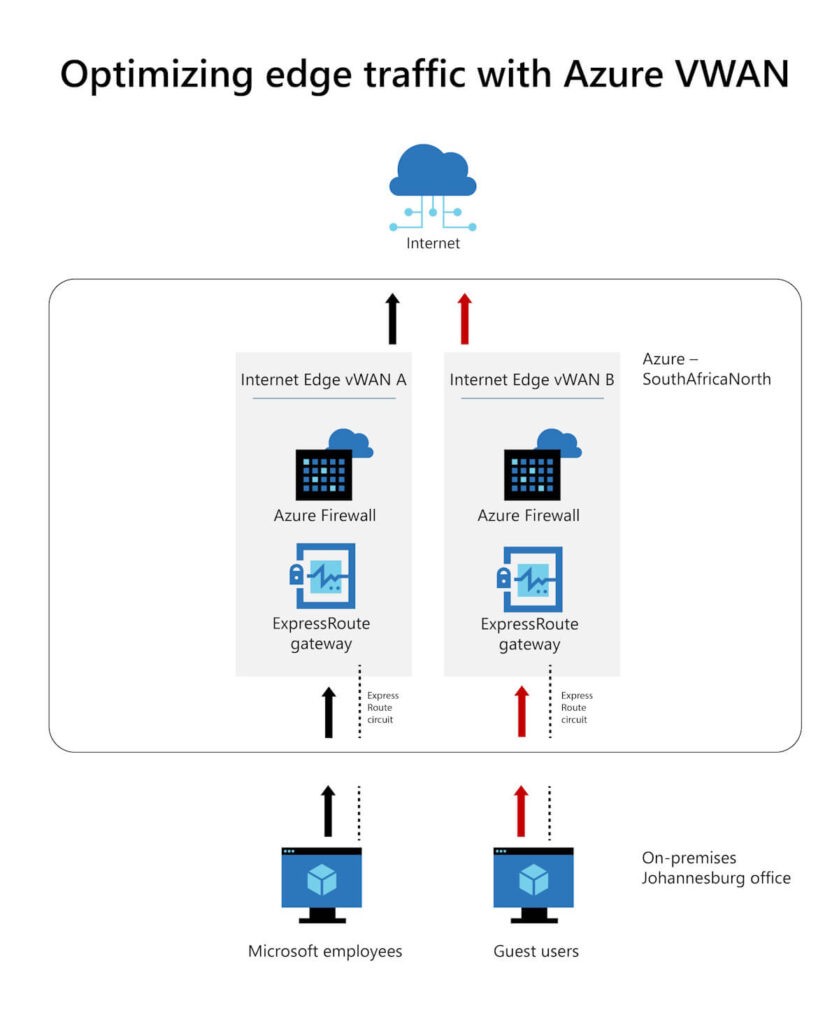 Editor’s note: This is the fourth in our ongoing series on moving our network to the cloud internally at Microsoft.
Editor’s note: This is the fourth in our ongoing series on moving our network to the cloud internally at Microsoft.
Whether our employees are in neighboring cities or different continents, they need to communicate and collaborate efficiently with each other. We designed our Microsoft Azure-based virtual wide-area network (VWAN) architecture to provide high-performance networking across our global presence, enabling reliable and security-focused connectivity for all Microsoft employees, wherever they are.
We’re using Azure to strategically position enterprise services such as the campus internet edge in closer proximity to end users and improve network performance. These performance improvements are streamlining our site connectivity worldwide and improving the user experience, increasing user satisfaction and operational efficiency.
We’ve recently piloted this VWAN architecture with our Microsoft Johannesburg office. Our users in Johannesburg were experiencing latency issues and sub-optimal network performance relating to outbound internet connections routed through London and Dublin in Europe. In other words, employees had to go to another continent in order to reach the internet.
To simplify the network path for outgoing internet traffic and reduce latency, we migrated outbound traffic for two network segments in Johannesburg to the Azure Edge using a VWAN connected through Azure ExpressRoute circuits.
The solution relocates the internet edge for Johannesburg to the South Africa North region datacenter in South Africa, using Azure Firewall, Azure ExpressRoute, Azure Connection Monitor, and Azure VWAN. We’ve also evolved our DNS resolution strategy to a hybrid solution that hosts DNS services in Azure, which increases our scalability and resiliency on DNS resolution services for Johannesburg users. We’ve deployed the entire solution adhering to our infrastructure as code strategy, creating a flexible network infrastructure that can adapt and scale to evolving demands on the VWAN.
We’re using Azure Network Watcher connection monitor and Broadcom AppNeta to monitor the entire solution end-to-end. These tools will be critical in evaluating the VWAN’s performance, enabling data-driven decisions for optimizing network performance.
The accompanying high-level diagram outlines our updated network flows. We can support distinct user groups by isolating the guest virtual route forwarding zone (red lines) and the internet virtual route forwarding zone (black lines). This design underscores our commitment to robust outbound traffic control, ensuring a secure and optimized network environment.


We strongly believe our VWAN-based architecture represents the future of global connectivity. The agility, scalability, and resiliency of VWAN infrastructure enables increased collaboration, productivity, and efficiency across our regional offices.
Our pilot in Johannesburg proved that improvements in network performance directly affected user experience. By relocating the network edge to the South Africa region in Azure instead of our datacenter edge in London/Dublin, latency for connections from Johannesburg to other public endpoints in South Africa has dropped from 170 milliseconds to 1.3 milliseconds.
Latency for other network paths has also improved, but by lesser amounts depending on the specific destination. The improvements were always greater the closer the destination was to Johannesburg, including connectivity paths to the United States and Europe, demonstrating stability and reliability in these critical connections. Significant benefits of the VWAN solution include:
- Increased scalability and flexibility. Our architecture is built to scale with our business needs. Whether we have a handful of regional buildings or a continent, the VWAN solution can accommodate any dynamic growth pattern. As our service offering expands, we can easily add new locations and integrate them seamlessly into the VWAN infrastructure.
- Greater network resilience. Continuous connectivity is essential to effective productivity and collaboration. Our architecture incorporates redundancy and failover mechanisms to ensure network resilience. In case of a network disruption or hardware failure, the VWAN solution automatically reroutes traffic to alternative paths, minimizing downtime and maintaining uninterrupted communication.
- Improved security and compliance. Protecting our data and ensuring compliance is our top priority. Our VWAN-based architecture is secure by design that incorporates industry-leading security measures, including encryption, network segmentation, and access controls. We adhere to the highest security standards that help Microsoft safeguard sensitive information in transit and meet compliance requirements.
We’re currently planning our VWAN-based architecture to span multiple global regions, offering extensive coverage and enabling our employees to connect to their regional and global services through the Azure network backbone as we continue prioritizing network performance to deliver exceptional connectivity for voice, data, and other critical applications.
We’re working to build improvements into the architecture for more optimized routing, improved Quality of Service (QoS) mechanisms, and advanced traffic management techniques to minimize latency, packet loss, and jitter, ensuring robust and low-latency connections to facilitate seamless communication regardless of where our employees are located.
Contact us today to explore how our cutting-edge VWAN-based architecture can transform your organization’s networking capabilities and revolutionize how your employees connect and communicate globally. Email us and include a link to this story and we’ll get back to you with more information.

- Assess your organization’s current network performance and needs to understand the challenges remote employees and satellite offices face regarding latency and connectivity.
- Incorporate Microsoft Azure for improved scalability, flexibility, and resilience so you can strategically position cloud services near end users, improving latency and overall user experience.
- Adopt an infrastructure-as-code approach to deploy flexible virtual network infrastructures. This streamlines the deployment process and ensures adaptability to ever-changing network demands.
- Invest in monitoring tools to gain valuable insights into the VWAN’s performance, which will help you make data-driven decisions for optimization.
- Adopt a VWAN-based architecture that emphasizes security measures such as encryption, network segmentation, and strict access controls. Ensure that the architecture adheres to the highest security standards, safeguarding sensitive information and meeting compliance requirements.
- Keep updated on advancements in network routing, Quality of Service mechanisms, and traffic management techniques. This will help you minimize latency and ensure robust, low-latency connections, enhancing global communication for your employees.

- Discover deploying a VWAN using infrastructure as code and CI/CD.
- Learn more about building a secure and efficient self-service application using Azure services.
- Explore the learnings, pitfalls, and compromises of Microsoft’s expedition to the cloud.
- Unpack verifying device health at Microsoft with Zero Trust.





